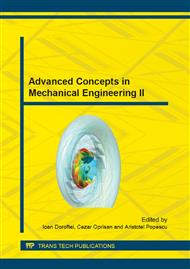[1]
S. Silveira, Bioenergy - Realizing the Potential, Elsevier, Swedish Energy Agency, Eskilstuna, Sweden, (2005).
Google Scholar
[2]
D.B. Levin, L. Pitt, M. Love, Biohydrogen production: prospects and limitations to practical application, International Journal of Hydrogen Energy, 29 (2004), 173-185.
DOI: 10.1016/s0360-3199(03)00094-6
Google Scholar
[3]
K. Nath, D. Das, Hydrogen from biomass-Review, Current Science, 85 (2003) 265-271.
Google Scholar
[4]
N. Mosier, C. Wyman, B. Dale, E. Richard, Y.Y. Lee, M. Holtzapple, M. Ladisch, Features of Promising Technologies for Pretreatment of Lignocellulosic Biomass, Bioresource Technology, 96 (2005) 673-686.
DOI: 10.1016/j.biortech.2004.06.025
Google Scholar
[5]
Y. Sun, J. Cheng, Hydrolysis of lignocellulosic materials for ethanol production: a review, Bioresource Technology 83 (2002) 1-11.
DOI: 10.1016/s0960-8524(01)00212-7
Google Scholar
[6]
M. Nakamura,K. Kanbe, J. Matsumoto, Fundamental studies on hydrogen production in the acid-forming phase and its bacteria in anaerobic treatment processes-the effects of solids retention time, Water Science Technology, 28 (1993) 81-88.
DOI: 10.2166/wst.1993.0146
Google Scholar
[7]
C. Ciubota-Roșie C., M. Gavrilescu, M. Macoveanu, Biomass - An important renewable source of energy in Romania, Environmental Engineering and Management Journal, 7 (2008) 550-568.
DOI: 10.30638/eemj.2008.079
Google Scholar
[8]
D.F. Toerien, H.J. Hattingh, Anaerobic Digestion I. The Microbiology of Anaerobic Digestion, Water Research, 3 (1969) 385-416.
DOI: 10.1016/0043-1354(69)90002-5
Google Scholar
[9]
J.D. Brosseau, J.E. Zajic, Continous Microbial Production of Hydrogen Gas, International Journal of Hydrogen Energy, 7 (1982) 623-628.
DOI: 10.1016/0360-3199(82)90186-0
Google Scholar
[10]
S. Rochowdhury, D. Cox, M. Levandowsky, Production of hydrogen by microbial fermentation, International Journal of Hydrogen Energy, 13 (1988) 407-410.
DOI: 10.1016/0360-3199(88)90126-7
Google Scholar
[11]
A. Tawfik, H. El-Bery, S. Kumari, F. Bux, Use of mixed culture bacteria for photofermentaive hydrogen of dark fermentation effluent, Bioresource Technology, (2014), in press, http: /dx. doi. org/10. 1016/j. biortech. 2014. 03. 065.
DOI: 10.1016/j.biortech.2014.03.065
Google Scholar
[12]
S.V. Sathyanarayanan, S.R. Chaganti, J.A. Lalman, D.D. Heath, Optimizing hydrogen production from a switchgrass steam exploded liquor using a mixed anaerobic culture in an upflow anaerobic sludge blanket reactor, International Journal of Hydrogen Energy, 39 (2014).
DOI: 10.1016/j.ijhydene.2013.12.057
Google Scholar
[13]
Y. Gu, X. Chen, Z. Liu, X. Zhou, Y. Zhang, Effect of inoculum sources on the anaerobic digestion of rice straw, Bioresource Technology, 158 (2014) 149-155.
DOI: 10.1016/j.biortech.2014.02.011
Google Scholar
[14]
P. Parthasarathy, K.S. Narayanan, Hydrogen production from steam gasification of biomass: Influence of process parameters on hydrogen yield. A review, Renewable Energy, 66 (2014) 570-579.
DOI: 10.1016/j.renene.2013.12.025
Google Scholar
[15]
M. Balat, Potential importance of hydrogen as a future solution to environmental and transportation problems, International Journal of Hydrogen Energy, 33 (2008) 4013-4029.
DOI: 10.1016/j.ijhydene.2008.05.047
Google Scholar
[16]
P. Kaparaju, M. Serrano, A.B. Thomsen, P. Kongjan, I. Angelidaki, Bioethanol, biohydrogen and biogas production from wheat straw in a biorefinery concept, Bioresource Technology, 100 (2009) 2562-2568.
DOI: 10.1016/j.biortech.2008.11.011
Google Scholar
[17]
Y.T. Fan, Y.H. Zhang, S.F. Zhang, H.W. Ou, B.Z. Ren, Efficient conversion of wheat straw wastes into biohydrogen gas by cow dung compost, Bioresource Technology, 97 (2006) 500-505.
DOI: 10.1016/j.biortech.2005.02.049
Google Scholar
[18]
K.B. Cantrell, T. Ducey, K.S. Ro, P.G. Hunt, Livestock waste-to-bioenergy generation opportunities, Bioresource Technology, 99 (2008) 7941-7953.
DOI: 10.1016/j.biortech.2008.02.061
Google Scholar


